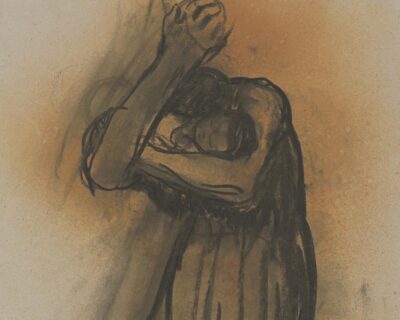Kathe Kollwitz: Art of Protest
Danica Ramos
345-101-MQ
Throughout history, art has had a variety of purposes. It could be used to tell a story or just to simply look beautiful. Kathe Kollowitz’s art however is used to encourage people to take action and is a form of protest. She depicts various perspectives allowing the audience to have a stronger connection to her art. Kollowitz uses intense emotion to instil a need to take action into the viewer. Her choice of medium allows her to disperse her anti-war ideas. Kollwitz’s approach to anti-war art is an effective form of protest.
Kathe Kollwitz depicts relatable perspectives, which are able to reach a larger audience. Often when looking at war time art, the same stereotypical image of a brave or grieving soldier is depicted. It is widely believed that since soldiers experience war firsthand, they are the only ones able to accurately depict it and its tragedies (Sharp 89). This offers a very polarized view on who is impacted. It does not take into account the rest of the population that is suffering because of the war. Due to the fact that men were mostly out fighting the war, Germany’s population at this time consisted primarily of women, many of which were mothers (Siebrecht 106). These individuals, like the soldiers, are greatly impacted by the war as a majority of the deaths consist of young men with “almost 40 percent of the German war dead were young men aged between 20 and 24” (Siebrecht 106). This would mean that a majority of the German population would be struggling with the grief of the loss of a child, something Kollowitz herself is affected by. This pain and art were often swept aside as it comes from civilians, specifically women, rather than the soldiers (Sharp 89). This theme of grieving mothers can be seen through Kollwitz’s work. An illustration of this is in her drawing, ‘Stehende Mutter, Säugling ans Gesicht drückend’ (Standing Mother, Pressing Infant to her Face).

Different perspectives are shown, such as that of a mother and child, where the child in the art represents the soldiers to bring awareness to their youthfulness and innocence (Siebrecht 117). Kollwitz uses these perspectives to relate to a larger population, allowing her works to be seen and understood, therefore having a larger impact in spreading anti war ideas.
Kollwitz’s use of emotion captivates the viewer and allows a deeper sense of need for action. All of her works stem from her own pain and raw emotions. This comes from losing her “son Peter, who was killed at the front in October 1914” (Siebrecht 1). This loss profoundly affects Kollwitz as shown through her works consisting mainly of parents mourning their children. There are strong sentiments of sorrow and grief throughout all of her artwork, no matter the medium. One example is of her statues, Die trauernden Eltern (The Grieving Parents), which was made to commemorate her son who passed (Siebrecht 1).

Through the posture of these statues the viewer is given some insight to Kollwitz’s agony, despite their simplicity. The body language does volumes to demonstrate emotional pain, as they are bent over on their knees with their arms over their chests as if to protect or comfort themselves. The creation of these statues took an emotional toll on Kollwitz as her diaries reveal “the process of creating the memorial was a painful one that was frequently interrupted by periods during which she felt overwhelmed by emotional distress and daunted by the magnitude of her self-appointed task” (Siebrecht 1). Her use of emotion to show the truth is especially important with “right-wing forces [who] are appropriating the myth of a glorified war experience to boost nationalism and prepare for another war” (Sharp 90). She pulls on personal emotions to work against propaganda and depict to the viewer a sense of wrong and injustice making them more likely to sympathize with anti-war ideas.
Kollwitz’s medium allows her the ability to disperse her critiques of the war quickly and easily. Her main mediums consist of woodcuttings, drawings and sometimes statues. Many of her works are displayed in places accessible by the public, allowing her art and thus her ideas to be seen. For example, her “major work of the period 1919–1925 was the cycle of woodcuts, War, completed in 1923 [is] published in Dresden in 1924 by the Emil Richter gallery” (Murray 3). Another example is seen with the statues she created in memory of her son, which sit at “the German military cemetery at Eesen Roggeveld in Flanders” (Siebrecht 1). The location is important as the statues are seen by numerous other families visiting those they too have lost and could relate to her ideas. These ideas of anti-militarism are very prominent through her works, which are displayed and can be seen by the public.
To conclude, Kathe Kollwitz’s art is an effective form of protest. This is due to her different approach to war art, offering a civilian’s perspective rather than the one of a stereotypical glorified soldier. Her use of emotion allows the viewer to sympathize and stirs them to want to act while her medium allows her art to be widely seen. Overall, Kollwitz’s art efficiently works against propaganda to popularize anti-war ideas in the public.
Works Cited
Murray, Ann. Käthe Kollwitz: Memorialization as Anti-Militarist Weapon. MDPI, 2020. https://dc153.dawsoncollege.qc.ca:2137/article/e44fac46656a463aba547d14ad68dfd9.
Sharp, Ingrid. Käthe Kollwitz’s Witness to War: Gender, Authority, and Reception. Women in German Yearbook, 2011.
Siebrecht, Claudia. The Aesthetics of Loss: German Women’s Art of the First World War. Oxford University Press, 2013.


